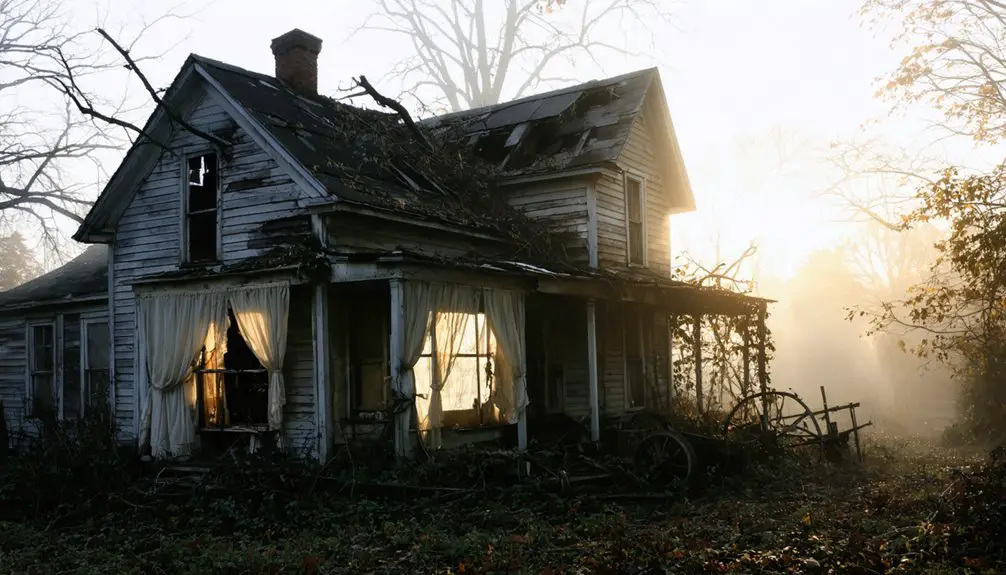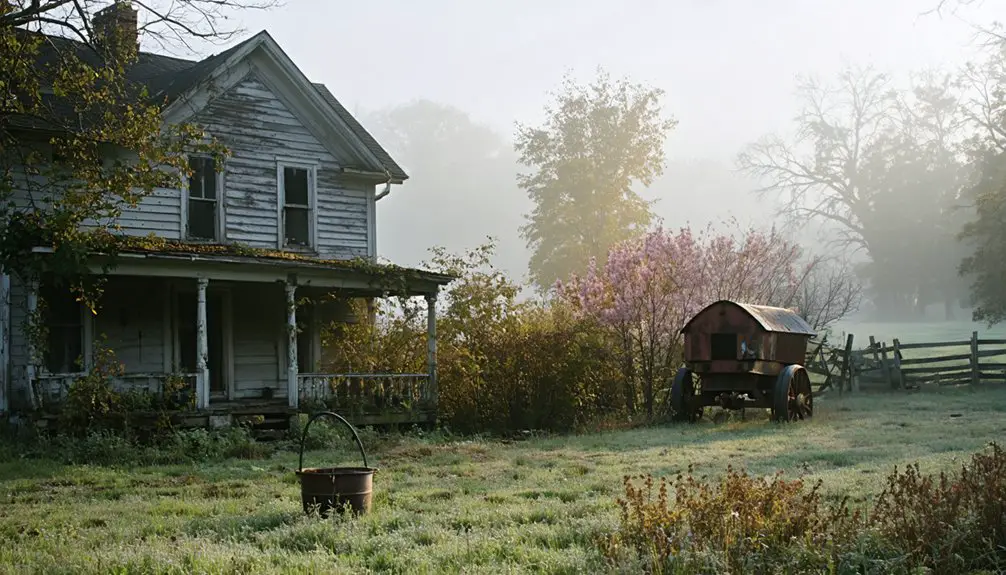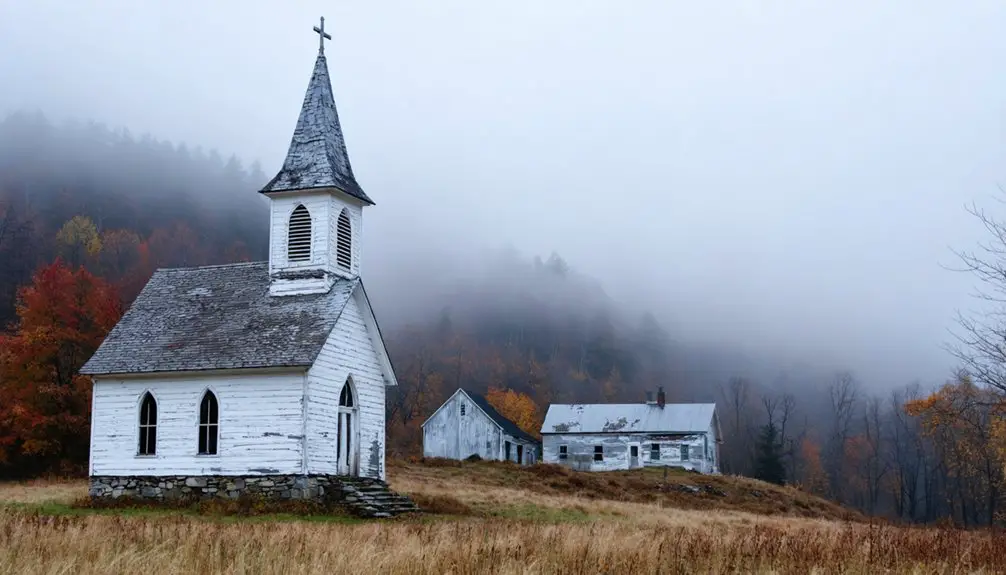You’ll find South Wheelock’s haunting remnants scattered across Vermont’s challenging terrain, where 90 working farms in 1920 dwindled to just 6 by 1984. The Wheelock House, built in the 1850s, stands among abandoned homesteads and tumbling stone walls that once marked thriving agricultural plots. Victorian-era graves in the Village Cemetery tell tales of mysterious reinterments, while the 1871 Town Hall’s Italianate belfry watches over a landscape where unexplained footsteps still echo through forgotten farmlands.
Key Takeaways
- South Wheelock declined from 90 working farms in 1920 to just 6 by 1984, leaving numerous abandoned farmsteads throughout the township.
- Poor soil conditions, isolation, and economic changes forced many young residents to leave by the late 1800s, contributing to community abandonment.
- The MacPherson Farmstead’s mysterious abandonment after an 1883 winter storm showcases the harsh conditions that led to property desertion.
- Agricultural decline accelerated as Midwest competition caused a 92% reduction in Vermont’s wheat production between 1869-1899.
- Challenging terrain, with elevations from 700 to 2,782 feet, created farming difficulties that ultimately contributed to South Wheelock’s ghost town status.
The Rise and Fall of a Rural Community
While many Vermont communities flourished in the early 1800s, South Wheelock’s story exemplifies both the promise and precariousness of rural New England settlements.
You’ll find evidence of community resilience in the Wheelock family’s prominent influence, particularly when Allen Wheelock built his distinctive home in the 1850s, blending local architecture with Southern designs from his Mississippi experiences. The spirit of Jonathan Wheelock’s ghost is said to still haunt his old farmhouse to this day. The deteriorating structures now draw visitors seeking to document and explore these abandoned buildings.
The town’s rural traditions centered on farming homesteads and modest commerce, sustained by multi-generational families who worked the land.
Yet by the late 1800s, you’d have witnessed the community’s gradual decline as young folks sought opportunities elsewhere. Poor soil conditions and steep terrain made farming increasingly difficult, while the absence of major transportation routes left South Wheelock isolated.
The lack of industrialization, combined with regional economic pressures, ultimately led to the community’s abandonment.
Geographic Features and Natural Challenges
Ye’ll note how South Wheelock’s terrain, with over 600 acres above 2,500 feet and its steep hillsides, made large-scale farming a mighty challenge for the settlers who tried to work this rocky ground.
The soil quality, typical of Vermont’s high country, proved too thin and acidic for most crops, save for the hardiest varieties that’d grow in these elevated conditions.
Down in the river valley along Miller’s Run, you’d find somewhat better conditions for small farms, but even there the uneven terrain limited the acreage any family could reasonably cultivate. Local historians suggest checking place name disambiguation records to understand the full scope of abandoned farming settlements in the area.
Steep Hills Impact Farming
Throughout South Wheelock’s settlement period, the region’s dramatic elevation changes – spanning from 700 feet at stream level to 2,782 feet atop Wheelock Mountain – presented formidable challenges for farming endeavors.
You’d have found yourself constrained by the steep terrain, forcing adaptation to hillside cultivation methods that relied heavily on manual labor rather than machinery.
The challenges were so significant that early settlers had to implement verification systems to ensure only genuine farmers, not land speculators, were granted plots.
The area’s average elevation of 412 meters made farming particularly difficult compared to surrounding lowland regions.
To work these unforgiving slopes, you’d need to employ careful erosion control techniques like terracing and contour plowing.
Your crop choices would’ve been limited to hardier varieties that could withstand the shorter growing seasons at higher elevations.
The rapid water runoff meant you couldn’t count on natural soil moisture, and you’d have to construct stone walls or terraces to retain what precious topsoil you’d on your carved-out patches of farmland.
Soil Quality Challenges
Despite the region’s abundant rainfall and scenic landscapes, South Wheelock’s soils presented formidable challenges for farmers due to severe nutrient imbalances and drainage issues.
You’d find excessive levels of phosphorus, potassium, and magnesium throughout the Winooski Valley region, making soil nutrient management a constant struggle.
The moderately well-drained soils along the South Wheelock branch proved particularly troublesome during flood events, when nutrient-rich runoff would wash away precious topsoil.
Local farmers faced an uphill battle with erosion management, especially in flood-prone zones where traditional farming methods proved ineffective. With annual precipitation increasing by over 7 inches since 1900, the erosion challenges only intensified over time.
Conservation buffers and wetlands offered some protection, but the combination of nutrient excesses and drainage challenges ultimately contributed to the area’s agricultural decline.
River Valley Terrain Effects
South Wheelock’s dramatic elevation changes, spanning from 206 meters at the valley floor to 848 meters atop Wheelock Mountain, created a challenging landscape for early settlers.
You’d have found the river valley’s steep terrain dictating every aspect of daily life. The South Wheelock Branch, cutting through at 215 meters elevation, brought both opportunity and risk. Situated at 1141 feet elevation, the local church stood as a testament to the community’s determination to build on this difficult terrain.
When spring thaws hit, you’d watch torrential waters cascade down those unforgiving slopes, threatening your homestead and washing out the primitive roads you’d labored to build.
The valley’s unique microclimate didn’t make things easier. Cold air would sink into these low-lying areas, creating frost pockets that shortened your growing season.
Between the constant threat of flash floods, landslides, and the limited buildable land, you’d understand why many folks eventually abandoned their river valley settlements.
Notable Historic Buildings and Structures
Historic buildings in South Wheelock showcase the architectural evolution of a once-thriving Vermont settlement.
You’ll find the 1871 Wheelock Town Hall standing prominently in the historic district, featuring Greek Revival styling with its distinctive Italianate belfry and traditional timber framing. The town common features a bandstand and memorial to Civil War veterans. The district’s cemetery rests above the river, marking generations of community heritage.
The Wheelock House represents mid-19th century historic architecture with its unique southern influences, brought north by Allen Wheelock from Mississippi. Its granite foundation and interior brick chimneys distinguish it from typical Vermont construction.
The earlier Jonathan Wheelock Farmhouse, built in 1789, reflects the area’s Revolutionary-era roots. Both structures tell the story of the Wheelock family’s influence on local development, from religious leadership to architectural innovation. Local residents report frequent poltergeist activity within the farmhouse, with unexplained movement of objects and items falling from shelves.
Tales and Legends From South Wheelock

If you’d wander through South Wheelock’s abandoned sites today, you’ll find the once-stately Wheelock House stands proof to persistent local tales of midnight apparitions and unexplained footsteps that’ve spooked visitors since the 1890s.
The town’s centuries-old cemetery, dating back to the earliest settlements, harbors whispered accounts of eerie orbs and strange lights documented in the Historical Society’s files from 1902-1947. Local stories tell of desperate families who would freeze their elderly during particularly harsh winters, claiming they could revive them in spring using special tonics.
You’ll hear old-timers tell of the cursed MacPherson farmstead where, as recorded in town meeting minutes of 1883, an entire family vanished during that winter’s brutal storm, leaving behind only tracks in the snow that mysteriously ended at their front door.
Haunted Wheelock House Stories
Through generations of local storytellers, the haunted reputation of Wheelock House has grown into a rich tapestry of supernatural lore.
You’ll find accounts of ghostly encounters tied to the house’s unique Southern-influenced architecture, particularly around the distinctive octagonal porch columns that Allen Wheelock reportedly brought north from Natchez, Mississippi.
Local records mention spectral sightings along the continuous railing staircase leading to the attic, where witnesses claim to hear unexplained footsteps.
The most compelling tales center on possible spirits of enslaved people who may have helped construct the house in the 1850s.
While these accounts lack official documentation, the house’s commanding position overlooking the West River and its architectural oddities continue to fuel South Wheelock’s supernatural narrative, making it a cornerstone of regional folklore.
Local Cemetery Mysteries
Deep within South Wheelock’s hallowed grounds, the Village Cemetery harbors tales of mysterious re-interments and Victorian symbolism that you’ll discover across its historic plots.
You’ll find evidence of grave relocation in the stories of Benjamin Carter and Sarah Woodman, whose remains were moved to the cemetery after its 1827 establishment.
The cemetery’s Victorian-era monuments tell their own tales through intricate symbolism – thirteen towering obelisks stand sentinel while six slate stones bear weeping willow carvings, symbols of mourning and immortality.
Two ornate granite plinths with carved urns mark the graves of prominent townspeople.
While official records don’t document supernatural occurrences, local folklore whispers of mysteries surrounding these early settler re-interments, adding an air of intrigue to this historic burial ground.
Abandoned Farm Folklore
Beyond the cemetery’s Victorian monuments lies another layer of South Wheelock’s haunting past – the abandoned farms that dot the township’s rural landscape.
You’ll discover weathered homesteads where local lore speaks of ghostly encounters near crumbling barns and farmhouses, their histories intertwined with tales of mysterious disappearances and family tragedies.
As darkness falls, witnesses report eerie sounds echoing across overgrown fields – phantom footsteps in empty corridors and unexplained voices carried on the night wind.
These abandoned properties, some dating back to Vermont’s agricultural heyday, harbor stories of cursed lands and troubled spirits.
Local accounts tell of cold spots in deteriorating farmhouses and apparitions glimpsed through broken windows, while oral histories blend documented hardships with supernatural elements that’ve become deeply embedded in South Wheelock’s cultural fabric.
Early Settler Families and Social Fabric

During the early settlement of South Wheelock, prominent families wove an intricate social tapestry that would define the community’s character for generations.
You’ll find the Wheelock family at the heart of these settler connections, having established deep roots from their Massachusetts origins. They’d soon be joined by the Hoyt brothers from Canterbury – Abner, Thomas, and Barnard – who’d help shape Caledonia County’s development.
The interweaving of family networks grew stronger through strategic marriages, like John Ross and Dorothy Wheelock’s union in 1810.
These bonds created a resilient community structure where extended family units formed the backbone of local governance and commerce.
You’ll notice how the Dow, Cree, and Fairbanks families contributed to this rich social fabric, establishing stores and strengthening the town’s economic foundation.
Agricultural Decline and Abandonment
While South Wheelock’s agricultural prominence seemed secure in the mid-1800s with its 4,787 sheep, 1,472 cattle, and 1,000 pigs, you’ll find that the town’s farming legacy began an irreversible decline by the turn of the 20th century.
From prosperous pastoral roots with thousands of livestock, South Wheelock’s agricultural golden age faded as the 19th century drew to a close.
The stark reality of changing rural economics hit hard as farming practices proved unsustainable on the region’s thin, steep soils.
- Working farms plummeted from 90 in 1920 to just 6 by 1984
- Competition from Midwest farms slashed Vermont’s wheat production by 92% between 1869-1899
- Water-powered mills along Miller’s Run couldn’t prevent the exodus of young farmers
You can still see evidence of this decline today in the abandoned farmsteads, where washed-out barnyards and crumbling stone walls tell the story of a once-thriving agricultural community that succumbed to economic pressures and soil exhaustion.
Documenting a Lost Vermont Village
As historians and preservationists attempt to piece together South Wheelock’s story, you’ll find the documentation scattered across various sources, from the prominent Wheelock House’s architectural records to local folklore preserved in the Wheelock News.
Unlike many Vermont towns, you won’t discover a formal historical society safeguarding South Wheelock’s cultural heritage, making each fragment of information precious to understanding this lost village.
The town’s architectural influences tell a unique tale through the Wheelock House, with its distinctive Southern elements and ties to Natchez, Mississippi.
You can trace the community’s spirit through surviving structures like the 1976 rebuilt bandstand and the Old Red Schoolhouse, while local narratives and folklore fill gaps where official records fall short in preserving this vanished community’s legacy.
Frequently Asked Questions
Are There Any Remaining Residents Living in South Wheelock Today?
You’ll find a gazillion current inhabitants living there today, contrary to any ghost stories you’ve heard. Census data confirms active residency, with South Wheelock remaining part of Wheelock’s thriving Vermont community.
What Is the Best Time of Year to Visit South Wheelock?
You’ll find the best seasonal attractions during fall (September-October), when crisp weather combines with stunning foliage. Visitor experiences peak as fewer bugs, mild temperatures, and firm roads make exploration more accessible.
Is Special Permission Required to Explore the Abandoned Buildings?
You’ll need explicit permission to legally explore abandoned buildings since they’re private property. Don’t risk trespassing charges or building safety hazards – there aren’t any general exploration permits available.
How Accessible Are the Historic Cemeteries to the Public?
You’ll find these historic cemeteries are publicly accessible without strict regulations, though you’ll need to navigate rough terrain, crossing swampy woodlands and uneven ground to reach these remote burial grounds.
Have Any Artifacts From South Wheelock Been Preserved in Local Museums?
You won’t find preserved artifacts in local museums, as there’s no documented local history collection specifically housing South Wheelock items. Most artifact preservation efforts focus on broader Vermont regions or private holdings.
References
- https://en.wikipedia.org/wiki/Wheelock_House_(Townshend
- https://www.vermonter.com/vermont-ghost-stories/
- https://preservationinpink.wordpress.com/abandoned-vermont/
- http://sites.rootsweb.com/~vtcaled2/cem.htm
- http://www.nvda.net/pdf/Towns/Wheelock/TP.ZB.Maps/WheelockTP11.1.01.PDF
- https://en.wikipedia.org/wiki/Wheelock
- https://nvda.net/town_files/Wheelock_Town Plan_May 21
- https://en.wikipedia.org/wiki/Wheelock_Common_Historic_District
- https://montpelierbridge.org/2022/10/ghost-towns-of-new-england/
- https://www.topozone.com/vermont/caledonia-vt/stream/south-wheelock-branch/



